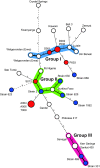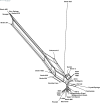Multi-locus sequence typing of Ehrlichia ruminantium strains from geographically diverse origins and collected in Amblyomma variegatum from Uganda
- PMID: 21762509
- PMCID: PMC3151223
- DOI: 10.1186/1756-3305-4-137
Multi-locus sequence typing of Ehrlichia ruminantium strains from geographically diverse origins and collected in Amblyomma variegatum from Uganda
Abstract
Background: The rickettsial bacterium Ehrlichia ruminantium is the causative agent of heartwater in ruminants. A better understanding of the population genetics of its different strains is, however, needed for the development of novel diagnostic tools, therapeutics and prevention strategies. Specifically, the development of effective vaccination policies relies on the proper genotyping and characterisation of field isolates. Although multi-locus sequence typing (MLST) has been recently developed, only strains from geographically restricted collections have been analysed so far. The expansion of the MLST database to include global strains with different geographic origins is therefore essential. In this study, we used a panel of reference strains from geographically diverse origins and field samples of E. ruminantium detected from its vector, Amblyomma variegatum, in heartwater-endemic areas in Uganda.
Results: A total of 31 novel alleles (six, four, six, three, two, five, three, and two for gltA, groEL, lepA, lipA, lipB, secY, sodB, and sucA loci, respectively) and 19 novel sequence types (STs) were identified. Both neighbour-joining and minimum spanning tree analyses indicated a high degree of genetic heterogeneity among these strains. No association was observed between genotypes and geographic origins, except for four STs from West African countries. When we performed six different tests for recombination (GeneConv, Bootscan, MaxChi, Chimaera, SiScan, and 3Seq) on concatenated sequences, four possible recombination events were identified in six different STs. All the recombination breakpoints were located near gene borders, indicating the occurrence of intergenic recombination. All four STs that localized to a distinct group in clustering analysis showed evidence of identical recombination events, suggesting that recombination may play a significant role in the diversification of E. ruminantium.
Conclusions: The compilation of MLST data set across the African continent will be particularly valuable for the understanding of the existing genetic diversity of field isolates in African countries. Comprehensive information on the degree of cross-protection between strains and further understanding of possible relationships between genotypes and phenotypes such as vaccine efficacy are expected to lead to the development of region-specific vaccination strategies.
Figures



References
-
- Louw M, Allsopp M, Meyer E. Ehrlichia ruminantium, an emerging human pathogen--a further report. S Afr Med J. 2005;95:948–950. - PubMed
Publication types
MeSH terms
Associated data
- Actions
- Actions
- Actions
- Actions
- Actions
- Actions
- Actions
- Actions
- Actions
- Actions
- Actions
- Actions
- Actions
- Actions
- Actions
- Actions
- Actions
- Actions
- Actions
- Actions
- Actions
- Actions
- Actions
- Actions
- Actions
- Actions
- Actions
- Actions
- Actions
- Actions
- Actions
- Actions
- Actions
- Actions
- Actions
- Actions
- Actions
- Actions
- Actions
- Actions
- Actions
- Actions
- Actions
- Actions
- Actions
- Actions
- Actions
- Actions
- Actions
- Actions
- Actions
- Actions
- Actions
- Actions
- Actions
- Actions
- Actions
- Actions
- Actions
- Actions
- Actions
- Actions
- Actions
- Actions
- Actions
- Actions
- Actions
- Actions
- Actions
- Actions
- Actions
- Actions
- Actions
- Actions
- Actions
- Actions
- Actions
- Actions
- Actions
- Actions
- Actions
- Actions
- Actions
- Actions
- Actions
- Actions
- Actions
- Actions
- Actions
- Actions
- Actions
- Actions
- Actions
- Actions
- Actions
LinkOut - more resources
Full Text Sources
Research Materials

